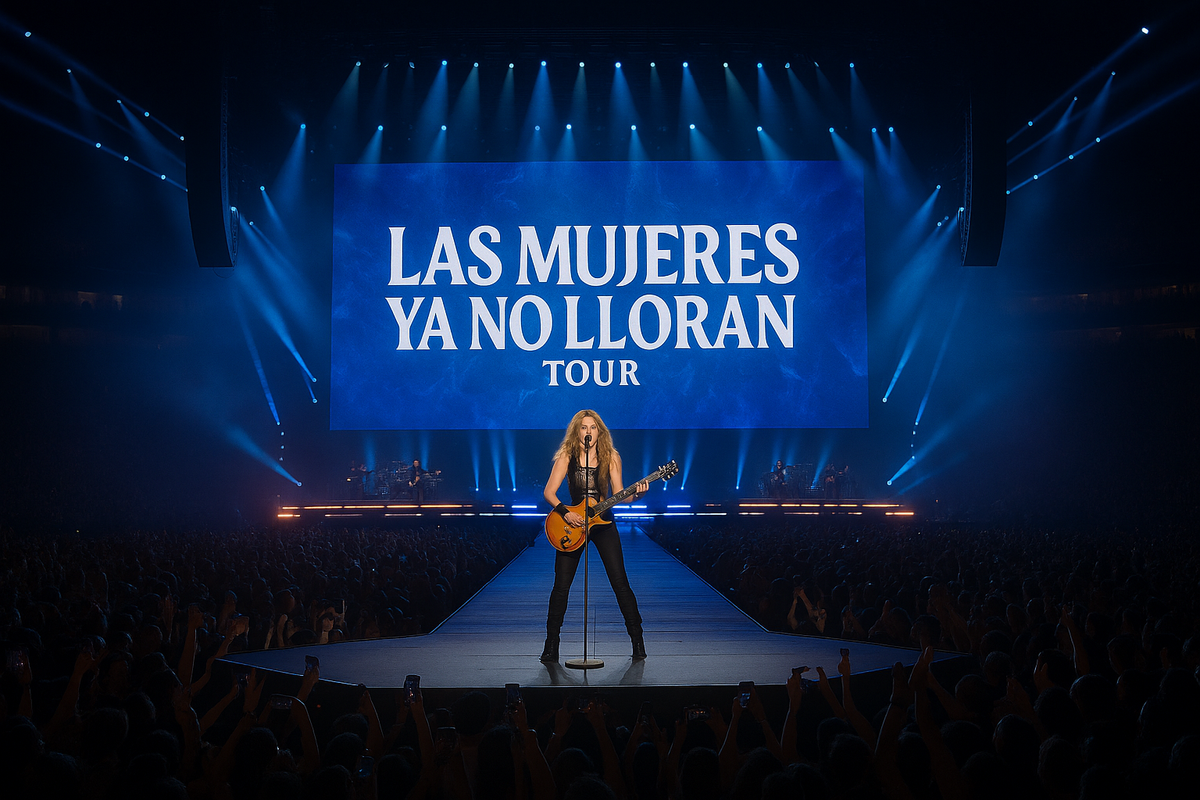Shakira’s “Las Mujeres Ya No Lloran” Tour: Miami Magic, 13 Costumes & Empowerment
Experience the Miami magic of Shakira’s “Las Mujeres Ya No Lloran” Tour electrifying costume changes, bold female empowerment, and a night of Latin-pop fire that redefined live performance in 2025.

INTRO: A Concert or a Cultural Moment?
When Shakira took to the stage at Hard Rock Stadium in Miami on June 6 and 7, she didn't just perform she redefined the playbook for what a female-led tour can be in 2025. Sold-out audiences, breathtaking imagery, raw emotional storytelling, and a show-stopping 13 costume changes this was no homecoming. This was a spiritual coming home, a victory of identity, and a feminist declaration.
Las Mujeres Ya No Lloran" (Spanish for Women Don't Cry Anymore) is more than the title of her album and tour. It's a battle cry for an artist and a generation—restoring emotional strength.
Miami's Electrifying Homecoming (June 6–7 Recap)
The energy in Miami’s Hard Rock Stadium was unlike any other. For two consecutive nights, more than 65,000 fans packed the venue each evening, screaming in Spanish and English, waving Colombian, Puerto Rican, and U.S. flags an organic reflection of Shakira’s global appeal and immigrant identity.
Opening with the explosive track “La Fuerte”, she emerged through a sea of flames in a glittering armor-style corset, launching immediately into high-octane choreography that confirmed this was going to be more than a greatest hits night.
From viral videos on Instagram, TikTok, and livestreams on YouTube, the entire performance felt cinematic in scale, yet intimately personal. She spoke directly to the audience:
"Miami, my second home. Gracias por amarme aunque estuviera muda."
Surprise guests at the concerts included Alejandro Sanz, who appeared with her to perform their hit duet "La Tortura," and Ozuna, who joined her on stage to sing "Monotonía," which elicited a deafening response from the audience.
13 Iconic Costumes & Precision Backstage Coordination
Arguably one of the most hyped aspects of the tour is Shakira's record-breaking 13 costume changes—yes, 13 full transformations within one performance. Leather catsuits, flowing flamenco skirts, shimmering ball gowns, and dominatrix silhouettes that screamed intimidation; the fashion was nothing less than haute couture performance art.
Each look served a purpose:
- Warrior corset for "La Fuerte" — representing emotional armor
- Emerald silk cape during "Hips Don't Lie" — an homage to tropical Latin glamour
- Tears-themed bodysuit in "Acróstico" — symbolically depicting catharsis
In the background, a 20+ person wardrobe team of experts performed lightning-fast changes with military-like precision. Two laundry teams on-site cleaned and ironed garments between performances. Each performance cycled through 300+ fashion items, some air-shipped in from Colombia, Italy, and India, according to reports.
Creative director Hannah Kinkade oversaw this fashion marathon with designers such as Versace, Anamika Khanna, Gaurav Gupta, and Atelier Zuhair Murad. Every look revealed a piece of Shakira's history and the crowd could sense it.
More Than Music—A Journey of Empowerment & Identity
Although the concert was visually stunning, its emotional resonance is what left fans in tears and critics speechless.
Shakira didn't only write about heartbreak or happiness she sang it through, for every woman who has ever been asked to keep quiet.
The Strength of the Title: "Las Mujeras Ya No Lloran"
This isn't marketing. This is a culture rebuke against the age-old cliché that a woman's strength lies in her silence or emotional resilience. Shakira turns this on its head:
- She's not keeping quiet about pain—she's dancing over it.
- She's not running from the past—she's rewriting it in sparkles and rebellion.
During the performance of "Acróstico," a tribute to her sons Milan and Sasha, Shakira was visibly crying on stage as the background showed a montage of home movies. Fans held their chests, weeping along.
"This song saved me. And they saved me," she whispered back, referring to her kids. "This is why I don't cry anymore. Because I'm building something stronger.
The Immigrant Narrative: Miami, Motherhood & Moving On
Few pop icons embody their immigrant status as proudly—and creatively—as Shakira. Their path from Barranquilla, Colombia to worldwide superstardom is one of legend. And Miami, with its multilingual, multicultural center, is the ideal city where that tale can build to its crescendo.
- Bilingual performances: switching smoothly between Spanish and English
- Latin fusion rhythms: cumbia, bachata, reggaeton, Afro-Colombian percussion
- Personal asides: mentions of her father's Lebanese heritage and mother's Caribbean background
She stopped mid-sentence at one point to declare:
"For every woman who crossed a border, changed her name, or started over—I see you."
The crowd went wild, bonding over commonalities. For many, this wasn't merely a concert a cultural reckoning.
The Musical Arc & Production Genius
The performance? On another level.Supported by a full band, dancers, and enormous LED visuals, the production transitioned from anthemic highs to acoustic lows with effortless ease.
Key Musical Moments:
- "Monotonía" with flames visuals representing destruction and renewal
- "She Wolf (Loba)" in captivity, shattering chains during the song
- "TQG" featuring Karol G playing on screen—a metaphorical passing of the torch
Shakira sang acoustic guitar, Arabic drums, and danced barefoot—keeping the spectacle rooted in raw artistry. Her voice was more powerful than ever, going from sultry lows to full-blast high belts that rocked the stadium.
Miami New Times and The Times (UK) critics described it as:
"A career-defining performance—a rare fusion of movement, meaning, and magnificence."
Fan Reactions & Critical Praise
Post-show hype online was charged:
- A leading Reddit comment stated:
"That wasn't just music. That was a testimony. We came out healed."
- Audience members complimented her on going from heartache ("TQG," "Última") to optimism ("Try Everything," "Whenever, Wherever"), all while dancing perfectly.
- One tweet captured it:
"Shakira didn't cry. She conquered. This is THE tour of the year."
POWERFUL SPOTLIGHT QUOTE
"This is Shakira's coronation—not just as a pop icon, but as a voice for women who refuse to stay silent."
ENGAGEMENT HOOKS
Let your readers engage:
Which part of the show touched you the most?
#ShakiraTour #FemPower #LatinaIcon
Use one of these prompts:
- Was it her tears, her dance, or her message that lingered with you most?
- Which of her 13 looks left you gasping for air?
- Did "Acróstico" strike differently now that we know her narrative?
CONCLUSION: Women Don't Cry, They Create
Shakira's Las Mujeres Ya No Lloran Tour is not just a musical tour. It's a visual autobiography, an immigrant's tribute, and a feminist manifesto encased in rhythm and sequins. In a year of stadium tours, hers was not the largest but it was the most substantial. She's not crying anymore she's commanding stages, sharing truths, and empowering millions.
And to that, we say: Loba forever.




